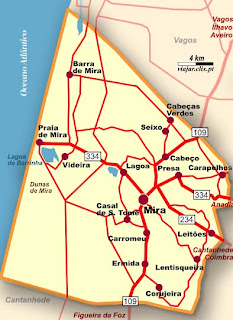 Mira is a Portuguese town in the district of Coimbra, Central and Sub-region of Baixo Mondego, with about 7800 inhabitants.
Mira is a Portuguese town in the district of Coimbra, Central and Sub-region of Baixo Mondego, with about 7800 inhabitants.It is the seat of a municipality with 123.89 km ² and 13,144 inhabitants (2004), divided into four parishes (Carapelhos, Mira, Mira and Pebble Beach).
The municipality is limited to the northern city of Aveiro, east and south and west by Cantanhede has coastline on the Atlantic Ocean.
The region where Mira has been inhabited for long time, although little is known of its early history. It is known that this settlement was occupied in Roman times and is attributed them to expand. From the Roman period were found some construction materials, namely "tegulae (roof tiles) and household pottery.
Little information exists about the time of the Visigoths in this region, but during the period of Arab rule, Mira was a village square with. As was the practice then, attackers replaced part of the population as people from other areas of the peninsula, and it was during this time that the town acquired the name Mira.
It seems that Christians have found there had favorite devotion to the Apostle Thomas, and the devotees used to call this place the Land Lord Sao Tome, which according to legend brought the Moors to accept the term that is in Arabic Emir.
Mira is corruption of the Arabic word mir or emir, meaning lord, chief or prince. But there are some historians who accept the idea that the Arabs, giving it that name, wanted to distinguish it for its beauty, location and mild climate, calling it Land of the Lord.
 With the Christian Reconquest, especially in the last achievement of Coimbra to the Arabs, the history of the lands of Mira will now be more clearly documented. The Moorish town was captured before the independence of the county of Portugal, perhaps by D. Henry, parents of D. Afonso Henriques.
With the Christian Reconquest, especially in the last achievement of Coimbra to the Arabs, the history of the lands of Mira will now be more clearly documented. The Moorish town was captured before the independence of the county of Portugal, perhaps by D. Henry, parents of D. Afonso Henriques.In 1442, Dom Pedro, regent of Portugal and Duke of Coimbra, granted local autonomy to Mira and various privileges to secure and develop the local population. Received a charter of King Manuel I in Lisbon that brings the town to August 27, 1514 and appointed as trustee of the village and Mr Dom Gonçalo Tavares. Later, D. Manuel de Sousa Tavares was lord mayor and chief of the village. The landlord of Mira remained in family hands until the century of Tavares. XVIII, when he joined the House of Queens. There he remained until the extinction of the manorial system in 1833.
Gastronomy
Roasted potatoes in the sand with grilled cod
Easter Cake
Stew mixed with Boleiros
You suck Wine
Beans to Gandaresa
Pumpkin donut
Papas Pumpkin
Pitau of Raia
Grilled Sardines
Sarrabulho stylish Mira
The municipality of Mira has four parishes, which are:
 Carapelhos is a parish with 3.92 km ² and 766 inhabitants (2001). Density: 195.4 persons per sq. km.
Carapelhos is a parish with 3.92 km ² and 766 inhabitants (2001). Density: 195.4 persons per sq. km.The Town of Carapelhos lies the source of the Municipality of Mira, limited by the side of the Town Angeão Source, County of Vagos, the south by the Town of cork de Cima, Cantanhede County, the Town by the west and north of Mira the Town of Pebbles, also of the Municipality of Mirth.
Economically, the people of this Town is dedicated mainly to agriculture. The little existing industry is linked to the processing of wood and aluminum frames, trade is reduced and is related to agricultural production.
Mira is a town and seat of both the parish and parish of the Diocese of Coimbra, 62.57 km ² and 7782 inhabitants (2001). Density: 124.4 inhabitants / km
Praia de Mira is a village and parish of 39.82 km ² and 2985 inhabitants (2001). Density: 75.0 inhabitants / km ².
The oldest known reference of Mira barns, which date from 1875 to refer to the town of Mira, she says "is 6 km far from the ocean and has road to 'haystacks of Mira, on the beach of the Sea", whose place residents are "almost all fishers'
The Pebble, also known as Pebble Mira, is a parish and parish of the Diocese of Coimbra, 15.70 km ² and 1339 inhabitants (2001). Density: 85.3 inhabitants / km ².
The Visit:
In the Town of Carapelhos
Church of Nossa Senhora da Conceição
Chapel of St. Benedict
Source of St. Benedict
Monument to the house Gandareza
In the Town of Mira
Church of St. Thomas
Pelourinho de Mira
Dam Young of St. Thomas
Statue of King Peter
Lagoa de Mira
Water Mill
Monument to the dead of World War
In the Town of Praia de Mira
Chapel of Praia de Mira
Statue in tribute to the people of Praia de Mira (Fishermen)
New Church of Praia de Mira
Ethnographic Museum
Barrinha Mira
Canal de Mira
Praia de Mira
Gravel Beach
In Town Pebble
Church of Our Lady of Mount Caramel
Monument to Moliceiro
Source Baroque
Power Up
Source Menez
Park S. John
House Gandaresa
Monument to the Mother Gandaresa
Cruise
Where to Stay
In the Town of Mira
Hotel Quinta da Lagoa (** Hotel / Resort ***)
Residential-handed
Camping Vila Caia - Agro Tourism Vila Caia
In the Town of Praia de Mira
Holiday Apartment D. Quixote
Mira Villas Aparthotel (****)
Fifth St. Joseph (Agro - Tourism)
Residential Sandpiper
Residential Rainbow
Residential Canadian Star
Residential Sea
Residential Miratlântico
Residencial Nossa Senhora da Conceição
Camping Municipal
Camping Orbitur
Youth Hostel of Mira

No comments:
Post a Comment